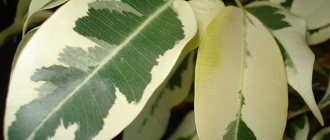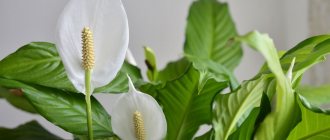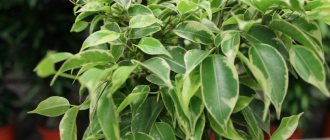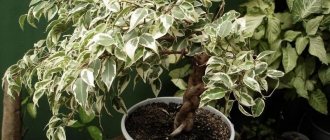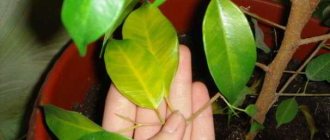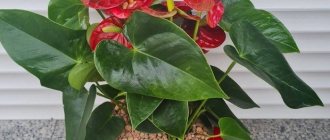Ficus benjamina is one of the most popular indoor plants among modern amateur gardeners. It is relatively unpretentious. But in order for a flower to feel good and delight its owners with its spectacular appearance, you need to know some secrets of its maintenance. You should also pay great attention to the prevention of diseases and parents, to which the plant is very sensitive.
Varieties and varieties
There are many varieties of this flower, bred by domestic and foreign breeders. As a rule, they differ in the shape and color of the leaves, as well as the height of the adult plant and life expectancy (which can be quite long with proper care). Most often, domestic gardeners grow the following species at home:
- with dark green leaves;
- with variegated leaves (mosaic pattern);
- with slightly curled leaves.
Not only the appearance, but also the characteristics of care depend on the variety. Some species are more vulnerable to diseases and pests, while others are more resistant; the same can be said about the requirements for fertilizing and soil moisture.
With green leaves
These plants have smooth, dark green, ovoid, slightly glossy leaves. The most popular varieties among domestic amateur gardeners are:
- Monique;
- Exotic;
- Anastasia;
- Dunetti.
They are quite sensitive to lack of moisture, but have good immunity to diseases and common pests.
Nicole
This is one of the shortest varieties, so it is recommended to grow it in small apartments where a tall plant with a branched crown will not fit. The leaves are dark green, glossy on the outside, their length reaches up to 6 cm. The leaves have an oblong ovoid shape, curve along the vein and are smooth at the edges.
Daniel
It is an evergreen plant that belongs to the mulberry family. The homeland of this variety is the Australian tropics. At home it grows up to two meters, and in nature – up to 30 meters inclusive. The glossy oval leaves are smooth along the edges and in the middle, their length reaches 5 cm. In a young plant they are light green, but darken with age.
Monique
This ficus grows quickly, the shoots are long and thin; If young growth is not trimmed in time, it bends and breaks. The lower leaves fall down in beautiful waves. The leaves are 5–6 cm long, glossy, dark green, with a pronounced convex vein in the middle.
Exotic
The height of an adult plant is 1.5 meters. The leaves are wavy at the edges and straight inside, dark green. A correctly formed crown has a pronounced spherical shape.
Anastasia
This is the most light-loving variety; it quickly withers in the shade. If the lighting is sufficient, the flower can grow up to 1.8 m, and the leaves reach 7 cm in length; if there is little light, the leaves become smaller and dry out. The dense, fleshy, dark green leaves are glossy and elliptical in shape.
Dunetti
The height of the plant is up to 3 m; under the right conditions, ficus often blooms, but the flowers are small and pale. The plant has a dense crown that requires regular pruning. The leaves are 5 cm long, fleshy, dense, light green.
Moklame
This variety has many aerial roots, the leaves are 6 cm long and have the shape of an ellipse. The height of an adult plant can reach 3 m if there is enough light in the room. The bark is gray and loose. The plant requires feeding.
Variegated (variegated)
These varieties look especially beautiful. Their leaves seem to be decorated with multi-colored mosaics that form intricate patterns. The most popular varieties:
- Twilight;
- Nina;
- Safari;
- De Gantelle.
These varieties require regular feeding. The pattern on the leaves may lose its original appearance due to fungal and viral infections, diseases and pests. To restore the shape of the leaves, the flower must be sprayed regularly.
Starlight
This is a plant of the mulberry family, the foliage has a beautiful mosaic marbled coloring that resembles marble. White spots stand out effectively against a dark green background. This is a unique color. However, this variety has a drawback - slow growth, only 10 cm per year.
Safari
Compact, low-growing variety, suitable for small apartments. The leaves are 4 cm long, separated by a vein, have a slightly curved shape, and marbled yellow-white spots are randomly scattered on them. In low light, the foliage turns yellow and growth slows down. For normal development, an additional source of lighting is required - a lamp.
Nina
Compact miniature variety, leaf blades are dark green in color, marbled white-yellow edging. The smooth, dense leaves reach 13 cm in length; each leaf has up to twenty lateral veins and one central one. In summer, small inedible berries appear on the plant.
Reginald
A tall variety, under good conditions can grow up to 3 m. The leaves are light green, with dark green small mosaic patches in the center, the leaves are 10 cm long. The bark is light gray, dense. The variety is unpretentious, but is afraid of drafts and cold.
Golden King
A distinctive feature of this variety is its shiny bright green leaves with a yellow stripe along the edges. In nature they grow up to 30 m in height, at home they can stretch up to 3 m, but with a lack of lighting the flower begins to grow very slowly. This variety is demanding on feeding and loves soil rich in nutrients.
De Gantelle
The leaves are elongated, heart-shaped, reaching 12 cm in length and 3 cm in width. The crown is dense, branched, and, when formed correctly, has the shape of a ball. The leaves are very light, almost white, but with dark green stripes. The plant is quite unpretentious in care, but due to the rapid growth of the root system, the ficus will have to be replanted frequently.
Twilight
The calling card of this variety is the leaves of a noble dark green color with a white edge. The contrast of white and green looks very impressive and immediately attracts attention. The plant can stretch up to 2.5 m with sufficient lighting and good watering. The central vein of the leaf is almost white due to the small amount of chlorophyll. The leaf length does not exceed 7 cm, most often up to 6 cm. The petioles are 1.5 cm long and dense and fleshy. The plant loves slightly acidic soils and does not tolerate nutrient deficiencies and lack of moisture. It is often affected by diseases, but is relatively resistant to the main ficus pests - scale insects, aphids and mites.
With curled leaves
These varieties require abundant and regular feeding. Due to a lack of nutrients, the negative impact of diseases and pests, and lack of moisture, the leaves can become deformed and lose their spectacular appearance. Most often, domestic lovers of indoor floriculture grow the following varieties:
- Natasha;
- Kinky;
- Irene;
- Boucle.
Shabo carnation seedlings: 5 useful tips for abundant flowering
These varieties are often affected by fungus and do not like strong soil moisture. They are highly sensitive to sudden changes in temperature and do not like cold and are afraid of drafts.
Baroque
The homeland of this interesting plant is Thailand, China and other countries in Southeast Asia with a warm and humid climate. Ficus baroque differs from its relatives in that it has small leaves, up to 4 cm, and a denser crown, as well as a more powerful trunk. Compared to other ficus trees, it looks more like a small tree than a shrub. The leaves are specially curled; in nature, during the rainy season, excess water flows down through them, like gutters. The variety is unpretentious in care; even an inexperienced gardener can handle it.
Boucle
The height of an adult plant is no more than 1.5 meters. The leaves are 5-6 cm long, 2.5 cm wide. The leaves curl slightly inward, forming beautiful half rings. The flower grows quite slowly. In order to stimulate growth, it is necessary to water the flower in time and fertilize it according to the season, as well as provide maximum lighting, including additional sources if the room is dark. The plant must be protected from drafts.
Among amateur flower growers, this variety also received the colloquial name “Kudryash”. The ideal placement option is on the east side of the apartment. You should not move the plant unnecessarily; any change of location will be very stressful for it. Due to slow growth, frequent replanting is also not recommended; it is enough to move the flower to a new pot every four years.
In winter, the plant tolerates dry air in the room well at the height of the heating season. But in summer it is necessary to regularly spray the flower with a spray bottle, otherwise the leaves will begin to dry out and become deformed.
Irene
This plant has an average growth rate, fleshy oval dark green leaves reach 5-7 cm in length, they curl beautifully in a spiral. The flower does not like the cold and does not tolerate high air humidity. The root system develops quickly; replanting is recommended once every three years. During seasonal feeding, fertilizers rich in potassium and magnesium should be regularly applied, since the plant is sensitive to a deficiency of these microelements. The optimal temperature for normal development and growth is 25 degrees. However, if the room suddenly becomes cold (up to 16 degrees), the ficus will calmly tolerate a short-term change in temperature.
Small-leaved
In Russia, such types of small-leaved ficus as Kinki and Natasha are common. They look beautiful and are not afraid of drafts. When growing, you should regularly loosen the soil and prevent moisture from stagnating in the pot; otherwise, the root of the flower may rot.
Natasha
The plant has a narrow cylindrical trunk with dense dark gray bark, the shoots fall beautifully down in the shape of waves. The leaves are oval, even in the center and along the edges, their length is up to 3 cm and width 1.5 cm. The leaves are bright green, there is a slight bend in the central vein. In nature, the plant has small round flowers, but it will not be possible to achieve flowering at home. In Thailand, this variety is considered sacred and many good omens are associated with it. In order for a flower to bring money into the house, you need to grow it in a green ceramic pot and bury a couple of coins in the ground.
Kinky
This is a compact variety that is well suited for small apartments. The crown is easy to trim and can be given any shape. Even a beginner can handle forming the top. The leaves are narrow, 7 cm long, dark green, with a white or cream edge. In order for the flower to grow quickly, the room must be at least 20 degrees Celsius. The main thing is to protect the ficus from drafts, especially in winter, since drafts can destroy the tree. Watering should be combined with regular spraying from a spray bottle. The plant does not bloom, but it may produce berries.
Description of the plant
Ficus Benjamina came to us from the tropical rainforests of Southeast Asia. It is named after the British botanist who specialized in seed plants, Benjamin Daydon Jackson. It grows in India, Southern China, the Philippines, Malaysia and Northern Australia. This is an evergreen representative of the Mulberry family. In a warm, humid environment, the tree can grow up to 30 meters in height, overgrown with branched shoots.
The trunk of the plant is gray-brown with rare brown streaks. Young erect shoots quickly become lignified. There are almost no aerial roots. The branches are drooping, forming a dense spreading crown. The leaves of Ficus Benjamin are thin, leathery, lanceolate in shape, with entire outer margins. Their length in large varieties reaches 13 cm, and their width up to 6 cm. In small-leaved varieties, the dimensions are much more modest. The central vein of light green color is clearly visible. The leaves are glossy. Different varieties have their own color - from light green to dark, with white, cream and yellow spots. Many varieties have edging on the leaves. The tip of each leaf is drawn into a drip point, characteristic of this type of ficus. Excess water flows down it and falls on the leaves.
Ficus leaves are located on the branches in the same plane. They sit on flexible short petioles (up to 2 cm), thanks to which even with the slightest breeze you can hear their amazing rustling.
Under natural conditions, ficus benjamina blooms with insignificant flowers. It bears fruit with oblong or round inedible paired fruits (syconia) up to 2 cm in diameter. As the fruit ripens, the color changes from red to burgundy. At home, ficus does not bloom or bear fruit.
The rhizome of Ficus Benjamin goes deep into the soil, at a distance often comparable to the height of the tree. However, the surface roots are also well developed. For example, they can easily break through the asphalt and intertwine with the trunk into a dense, intricate sculptural group.
In European countries with a dry climate, ficus benjamina grows as a single-stemmed tree with drooping branches, and is far from gigantic in size. Everywhere it is grown as an indoor flower in beautiful flowerpots as an ornamental foliage plant.
Young shoots of the plant are flexible and easily grow together. Flower growers use these properties to give the plant an unusual shape. If you have a creative streak, try to create from your ficus a unique, unique specimen, for example, with a pigtail stem, or with a crown similar to a ball or dome. Or maybe you want to grow a ficus tree in the form of a bonsai tree. To do this, you only need a great desire, a little patience, ingenuity and time - and your flower will gradually acquire the desired appearance.
A little about the benefits
Ficus benjamina is one of the top five filter plants. They purify the air by absorbing toxic substances from it (formaldehyde, benzene, toluene and the like, emitted by modern furniture, clothing, gas and heating appliances, electronics) and releasing oxygen into it.
This may be interesting: Fittonia: care at home
House conditions
Most varieties are quite unpretentious, but it is necessary to maintain an optimal temperature in the room and prevent the air from drying out. In winter, when the apartment has central heating, it is recommended to install an air humidifier in the room where the ficus grows.
Temperature
The optimal temperature for heat-loving varieties is 24 degrees. However, there are plants that grow well at temperatures of 20 degrees and below up to 18 degrees maximum). Tropical varieties require a temperature of 30 degrees; in this case, an additional heating source, for example, a lamp, must be installed in the room.
Humidity indicators
The humidity in the room where the ficus grows should be high. In summer, it is necessary to spray the flower daily, then moisture will evaporate around the plant, protecting it from severe overheating. Regular moistening is the best means of preventing diseases and pests, since parasites usually attack a weakened plant.
Lighting
Ficus does not like partial shade; it needs to be provided with a sufficient amount of sunlight. It is best to place the flower near the window, but slightly to the side, so as not to block the access of light to the room. If you have to place the ficus far from the window, a fluorescent lamp should shine nearby all the time.
Where to keep
Ficus is kept in the apartment all autumn, winter and spring, from September to May. In summer, the plant should be placed on a balcony or loggia, preferably on the outside of a window. The plant should not be placed near heating radiators.
5 useful tips on how to grow strong ageratum seedlings so as not to be left without beauty on your site
Soil selection
The best option for ficus will be the soil used when growing plants of decorative foliage varieties. Experienced gardeners often buy soil for mulberry plants or palm trees. Ficus needs a nutrient substrate with neutral acidity. It is advisable to choose a soil that is breathable.
It is also possible to prepare the soil yourself by mixing peat with garden soil and sand in the same combination. It won't hurt to add a small amount of wood ash to prevent acidity.
A dense substrate is more suitable for adult ficus plants, so turf soil with humus is mixed. It is important not to forget about arranging a drainage layer at the bottom. This can be expanded clay or drainage composition with charcoal.
Home care
The main requirement for care and maintenance at home is the presence of a large, spacious pot and regular replanting, since the ficus has a developed root system that grows very quickly. You should also pay attention to the watering regime. The soil in the pot should always be a little moist (but not too much).
The list of basic measures for caring for ficus includes:
- watering;
- fertilizing;
- transfer;
- pruning and crown formation.
It should be borne in mind that improper pruning can lead to deformation of the tree and deteriorate the appearance of the crown.
Priming
Regular soil for indoor plants is suitable for growing. It is necessary to lay a drainage layer of expanded clay at the very bottom of the pot so that excess moisture comes out, otherwise the earth will rot. You can add eggshells to the soil as a mineral fertilizer.
Tara
You can use a ceramic or plastic flower pot of any shape. The main thing is that it freely accommodates the powerful root system of the ficus. The plant grows quickly, and replanting is recommended at least once every three years. The pot must first be disinfected so that the plant does not get sick.
Watering
Ficus is a moisture-loving flower, so the optimal frequency of watering is once every three days. As soon as the soil has dried 2 cm deep, it is time to water again. In summer, watering should be done more often than in winter. If the top layer has not yet dried out, you need to wait a while with watering, otherwise you can create dampness in the ground and infect the ficus with a fungus, which is then very difficult to treat. The water should be at room temperature, pre-settled. It is strictly forbidden to water the flower with tap water; it has a detrimental effect on the root system and the general condition of the flower. Excess water must be drained from the pan in time.
Fertilizer (feeding)
The optimal time for fertilizing is from April to October; in the spring it is enough to fertilize the ficus once a month, and in June once every two weeks, because in the summer there is a peak of active growth and development. In winter, the flower is at rest; it does not need to be fertilized, but you can add eggshells and drunken tea as sources of calcium and potassium. Fertilizers are applied both at the root and on the leaves and stem - from a spray bottle.
The use of folk remedies gives good results. You can dilute two tablespoons of granulated sugar in 2 liters of water at room temperature and pour the ficus under the root from a watering can. Glucose stimulates plant growth. This fertilizer can be used once a month in the summer.
Trimming
Many varieties of ficus, especially those with spiral leaves, grow very quickly. If the excess shoots are not trimmed in time, they will grow chaotically, and the flower will take on an unkempt, neglected appearance. Therefore, young growth should be removed regularly. When pruning, you should not hesitate to remove dead branches, starting from the bottom and gradually moving up. Remove all wilted and dry leaves, as well as excess young growth. Ultimately, the crown should take on a spherical or oval shape.
Transfer
To replant, the flower is pulled out of the pot along with a lump of earth and transferred to another pre-prepared pot with a nutritious substrate for indoor plants. All resulting voids are carefully covered with earth, trying not to touch the leaves and stem. If the room is cold, you should refrain from watering for a couple of days. If the house is warm, you can immediately after transplanting, spray the plant with warm water from a spray bottle, but do not water it at the root.
Formation
To form a crown at home, pinch the top of the flower. All unnecessary branches are removed. The foliage at the top should be denser than at the bottom.
Rejuvenation
Rejuvenation is resorted to when the foliage begins to fall, and signs of dieback are visible at the top. In this case, you just need to carefully trim the plant so that only one stump remains. After this, young shoots will begin to appear quickly, and the vitality of the plant will be restored. But this method is stressful for the plant, so pruning must be done carefully; For three days from the moment of rejuvenation, you should refrain from watering and make sure that there are no drafts in the room.
Features of feeding
Ficus is fed in the spring-autumn period, and the frequency of supplementation will be different. In the period from March to April, feed once every 1 month, and in June, during active growth, you will need to feed up to once every 2 weeks. This regime continues until September. In autumn, the frequency of feeding is reduced to once a month, and in winter it stops completely.
Thanks to nutritious soil, the health of the plant can be improved. They use organic and mineral fertilizers; compost-vegetable compositions are also suitable. Mixtures for fertilizing ficus plants or complex formulations suitable for decorative foliage plants are offered for sale.
Nitrogen-rich fertilizers stimulate the growth of green mass. Foliar feeding is carried out with a spray bottle. For intensive development of new branches, the Epin solution is suitable.
If new leaves turn yellowish, this may be a signal of iron deficiency, and therefore you will need to use a Ferrovit solution.
Reproduction
There are different ways to propagate ficus. Growing from seeds is a rather labor-intensive and troublesome process; usually this method is used only by breeders for the professional development of new varieties. Amateur flower growers most often use the following types of flower propagation:
- leaf;
- seeds;
- layering.
By cuttings
Rooting a ficus cutting is easy. In order for the shoot to take root and take root, it must be planted in well-moistened soil with a nutrient substrate. A shoot 10 cm long is cut from the top, a pair of lower leaves are removed, and the milky juice that is released from the stem is washed off with water. The cut is dried in air and planted in the substrate.
By layering
For propagation by layering, a healthy and strong branch is selected, then it is cut at an angle along the internode and placed in a previously prepared nutrient substrate. Instead of a substrate, you can use water at room temperature, in which case the plant will be placed in the ground after final rooting.
Seeds
Ficus seeds have poor germination, and the flower grows from the seed very slowly, so this method is rarely used. But theoretically it can be used. Seeds should be pre-treated with potassium permanganate to prevent the development of diseases in the flower.
Leaf
To propagate ficus, you can use leaves. Typically, variegated varieties are propagated using this method. The leaf is cut off, and you need to grab a little of the shoot to which it was attached. The cutting is cut with a knife, the milky juice is removed and the leaf is placed in a pot or in water. In a few days, roots should appear. The main condition is high air temperature in the room, so it is best to propagate the plant in summer or winter with good heating (but in the second case you need a humidifier to maintain maximum humidity).
Strong watermelon seedlings: 6 useful growing tips
Humidity
Along with bright lighting, you should also take care of the humidity in the room. Dry air in the room should not be ignored. In this case, regular spraying will be required, especially in summer. In winter, the frequency of spraying is reduced.
For preventive purposes, it is recommended to periodically treat with aspirin solution - 1 table. for 1 glass of water. At the same time, wipe the leaves.
Regular refreshing showers are carried out as follows:
- The pot is placed in a bathtub or large basin.
- The soil is protected with a film to prevent leaching.
- The crown is watered with a shower. The water should be slightly warm.
After the plant has dried for an hour, it can be returned back to the windowsill.
Note!
- Kinusaiga technique - TOP-140 photos of the best ways to create crafts using the Kinusaiga technique with your own hands + instructions for beginners
- Do-it-yourself passe-partout - a master class with step-by-step do-it-yourself schemes. Making tips + photos of the best examples
- Decoupage with napkins: TOP-150 photos of ways to decorate with napkins. Simple instructions for beginners at home
In winter, indoor air usually becomes drier due to the use of heating devices. Therefore, you should regularly turn on the air humidifier or treat the ficus with a spray bottle of warm, settled water.
Pests
White lumps on the leaves are a sign of mite activity. Prevention - regular inspection of the plant and isolation of the ficus from other indoor flowers that may be affected by the pest. For treatment, industrially produced insecticidal solutions should be used.
If small uneven holes appear on the stems and leaves, it means that the flower is being nibbled by a bug. To cope with the pest, you can spray the plant with a solution of laundry soap. For prevention, it is necessary to promptly remove yellowed leaves and deformed shoots, because they are a tasty morsel for the scale insect.
Curled dry leaves are a sign of scale insects. Prevention - regular watering and frequent fertilizing. Control measures are to collect the scale insects by hand and burn the affected leaves, and then transplant the plant into another pot.
Rooting into the ground
The cutting can be immediately placed in the substrate. Some gardeners are convinced that this option allows you to grow a bush faster. True, the soil must be fertile, neutral acidic and breathable.
And you need to act as follows:
- The cutting is located in a small pot. Drainage must be placed at the bottom. The cutting is left in the center of the container and then covered with substrate.
- Take settled water, add Kornevin or other preparations of a similar effect, and then water the plant.
- Cover to create a greenhouse. An ordinary film or glass jar is suitable for this. Leave the structure in a warm place. The sun's rays should be diffused. Duration – 2-3 weeks until the first roots appear.
- Remove the cover after the specified time. If the plant begins to grow, then all actions have been performed correctly.
Flower growers recommend rooting several petioles in order to be able to choose the healthiest and strongest one.
Problems during cultivation
Inexperienced indoor plant lovers often encounter serious problems when growing ficus. However, these problems can be successfully solved and prevented. Most often, ficus owners complain about the following difficulties in caring for their flowers:
- yellow leaves;
- leaves soften
- new shoots become thinner;
- leaves wilt and curl for no apparent reason.
Most often this occurs due to a lack of moisture, nutrients and microelements. But there are other reasons.
Leaves wither and curl
It happens that the leaves suddenly begin to wither, and then curl and fall off. This happens because the plant lacks nutrients. To solve the problem, it is necessary to apply fertilizing. For prevention, you should trim the flower and form a crown, then the plant will spend its energy not on the formation of new shoots, but on feeding existing ones.
The tips of the leaves turn brown
If the tips of the leaves become brown or brown, it means that the roots of the flower have begun to rot. It is necessary to replant the plant after cutting off the affected roots. Prevention - regular loosening of the soil to prevent stagnation of moisture.
New shoots are thin
As the trunk forms, new shoots appear. If they are very thin and break quickly, the plant lacks microelements. The method of solution and prevention is quite simple - it is necessary to fertilize according to the season, paying special attention to fertilizers that contain calcium and magnesium.
The leaves are turning yellow
If the leaves turn yellow and then fly off, this is a sure sign of potassium deficiency. To solve and prevent the problem, it is necessary to fertilize with potassium fertilizers. Regular ash is also good; it is rich in potassium and other nutrients, and is also completely harmless. However, if the ficus has already turned completely yellow, it may not be possible to save it; Massive yellowing and falling of leaves is a sign of a root infection. In this case, a transplant can be performed, but it will also not guarantee salvation.
The leaves are falling
It happens that a flower drops its lower leaves. This happens due to moisture deficiency. To solve and prevent the problem, it is necessary to establish regular watering and not skip it. You should also give the plant a “shower” by spraying the leaves and stem with a spray bottle.
Leaves are soft
Soft leaves appear when there is a vitamin deficiency. To solve the problem, it is necessary to increase the amount of light in the room (perhaps move the ficus or place a lamp next to it as an additional light source). For prevention, it is necessary to regularly fertilize and ensure that the plant has enough light.
Yellow and brown spots on leaves
If yellow and brown spots appear on the leaves, this is a serious disease - viral mosaic. For treatment, it is necessary to transplant the plant into another pot with previously prepared soil, cut off and burn all affected leaves. Prevention - regular feeding and normalization of room temperature.
Sticky leaves
If the leaves are sticky, it means the plant has a fungal infection. Prevention - moderate moisture and regular loosening of the soil, adjusting the air humidity in the room. Treatment is transplantation into another pot, treatment with fungicides.
White plaque
It happens that an unpleasant and unsightly white coating appears on the leaves closer to the crown; such leaves become sticky and sticky to the touch. Most likely, such a plant is affected by aphids. Prevention - regular loosening of the soil and reducing watering. Aphids do not like tobacco smoke, so preventative fumigation is recommended.
Periodicity
At home, the flower is replanted in the spring - the most suitable time is March or April. Young ficus trees are replanted annually, and adult flowers - once every 3-4 years. In the process, it is necessary to remove the upper part of the substrate and fill its place with new soil.
To replant, remove the plant from the pot; be sure to leave a lump of earth on the root system. Using the transshipment method, the cutting is placed in the central area of a new container with a laid drainage layer and a layer of new soil. After this, the gaps are filled with substrate. It is advisable to shake the pot periodically.
If the temperature in the room is excessively high, it is advisable to treat the ficus with a spray bottle. But at low temperatures it is advisable to avoid watering for several days. All the features of care can be learned by watching the video.
Poisonous or not for humans and pets
The roots, stems and leaves of ficus do not contain toxic substances that can have a negative impact on the health of humans or animals, such as dogs or cats. The plant does not cause allergic reactions and is absolutely safe to grow. It can be planted in the living room, bedroom or kitchen. Ficus has rather hard leaves, so cats that often gnaw on indoor plants are likely to show interest in it.
It is certainly worth growing ficus benjamina at home. It will not only decorate the interior, but also help clean the air in the apartment from harmful impurities. If you believe good signs, a ficus in the house will help attract money and success, and will also bring harmony to family relationships. The main thing is to choose the most unpretentious varieties. However, this flower is not suitable for small apartments, as it grows quickly and can “eat up” the space.
Ficus small-leaved
Small-leaved ficuses do not grow into large trees, but rather into tall bushes with a dense, lush crown. With proper pruning, you can give the ficus any desired shape; on small-leaved ficus it looks most impressive.
Ficus Natasha
A very popular variety among ficus growers.
Small, up to 3 cm, deep green leaves are slightly bent along the central vein, and the tip of the leaf is slightly bent. Grows in a lush, dense bush. Unpretentious, but demanding of the basic rules of care - warmth, light, humidity, absence of drafts. Grows moderately quickly. Ficus benjamina Natasha (Ficus Natasha)
Ficus Wiandi
Another small-leaved variety with leaves up to 3 cm. Unlike the similar variety Natasha, the trunk of Viandi does not grow straight, but randomly twisting, which is the highlight of this variety and allows the formation of unusual bonsai-type mini-trees using the trunk.
Ficus benjamina wiandi (Ficus wiandi )
Ficus Kinky
Small green leaves with a small light (from light yellow to light green) uneven edging along the edge.
It grows as a low bush with a dense dense crown. It forms itself; additional pruning is required only to give it a certain shape. Ficus Kinky (Ficus Kinky)
Diseases
Plant diseases can be caused by non-compliance with care rules due to:
- lack or excess of watering;
- temperature disturbances;
- improper lighting;
- Excessive fertilizer application or lack thereof.
Florists may have several problems. In particular, the question is often asked why ficus Benjamina sheds its leaves and what to do in this case.
Usually the lower leaves fall off as the flower matures. This is a natural process, although it is advisable to study the conditions of detention - at excessively low or high temperatures, this effect can also occur.
Other known problems:
- Withering leaves begin to curl - this is evidence of hypothermia of the ficus.
- The ends of the leaves turn brown. The reason is very low humidity or dry air.
- Excessively thin shoots appear if the flower lacks light.
- The leaves of Ficus benjamina may turn yellow if the plant is watered too frequently, causing the roots to rot.
- The excessively soft structure of the leaves is a consequence of hypothermia.
- The appearance of yellow or brown spots is caused by sunburn of the leaves and excess lighting.
At the same time, there are more dangerous diseases caused by specific factors:
- botrytis - the formation of a whitish coating on the leaves;
- cercospora - dark blotches at the back of the leaf followed by wilting;
- anthracnose - dryness of the edges of the leaves with the appearance of brown spots.
If these problems appear, then the infected parts are removed from the plant, and the entire flower is quarantined and treated with a fungicide.
How to propagate ficus benjamina
There are three options for propagating this plant.
Propagation by cuttings
- For these purposes, they usually take a semi-lignified cutting, not too young, but not very mature either. It is cut with a sharp knife, and does not come off.
- The milky juice that appears on the cut must be washed off.
- To speed up the appearance of roots, it is recommended to cut the base of the cutting.
- The cutting takes root successfully in water, usually in 1-2 weeks.
- To create a greenhouse effect, a larger glass jar is sometimes placed above the jar with the cuttings.
- When the roots have appeared, the cutting is planted in the soil and covered with polyethylene.
Ficus benjamina cuttings
Reproduction by layering
To obtain layering, a ring-shaped cut is made on the lignified stem, then the bark is removed and this area is wrapped with damp sphagnum moss and polyethylene on top. Over time, roots will appear through this coating. Then the top is cut off and placed in prepared soil.
Growing ficus benjamina from seeds
Some gardeners soak the seeds in water for 1 day before planting, but this procedure is not necessary. Seeds are sown in moist soil consisting of sand and peat. They need to be evenly distributed over the surface and immersed 0.5 cm. To ensure heating, the container with the seeds is placed on the radiator if it is heating up. It is necessary to regularly ventilate and spray the seeds. After 1-2 months, the seeds produce their first shoots.
Among all these methods, the easiest and most effective is propagation by cuttings.
How to prune ficus benjamina
An important component of ficus care is its pruning. The growth rate of young shoots and branches is high; without pruning, the tree takes on a sloppy appearance, stretches upward and does not bush. Pruning is carried out in early spring, and in summer they only regulate the growth rate of individual shoots that stand out from the general mass.
Pruning allows you not only to control the development of the plant, but also to establish important air exchange in the crown of the tree, eliminate diseased or damaged parts, and prevent pest attacks and the development of diseases.
The branches are cut with sharp pruning shears, without cutting off more than 35% of the ficus crown at a time, otherwise the plant may get sick. In addition, large sections should be sprinkled with ash or crushed coal.
In most cases, the ficus is given the shape of an upright tree with a lush cap, but if desired, the plant can be given an extraordinary, bizarre shape; for this it is necessary to intertwine the trunks of several young plants and carefully secure them with plastic clamps, without interfering with the development of parallel trunks. As they grow, the trees will change, acquiring an unusual wicker shape of a single trunk, and after a few years they will completely grow together.
To ensure that the tree takes on even more fun shapes when pruning, we recommend watching a video on turning a ficus into a bonsai and being patient.
Final part
Ficuses are very sensitive flowers, so they do not like sudden changes in temperature; you need to monitor their location so that they do not stand in drafts or close to the radiator. If the air in the apartment is too dry, this can contribute to the appearance of spider mites. Due to the unusual shape of the leaf, you may simply not see it, so to prevent this from happening, you need to constantly and regularly wash the leaves of the flower.
Ficus Baroco is a unique and interesting flower that does not require special care. The main thing is to follow the basic rules regarding temperature and air humidity, and then a beautiful pearl will grow on the windowsill.
Ficus Benjamin: signs and superstitions
There are many superstitions associated with Ficus Benjamin. If in the East this plant is considered to be a symbol of wealth and prosperity, then in Russia and the CIS countries the ficus is called “muzhegon” and is credited with magical properties that have a negative impact on family members.
In China, Ficus Benjamin is given as a wedding gift and passed on from one generation to another, and in some Eastern countries this beautiful tree is considered sacred. At home, ficus is able to absorb negative energy, attract wealth into the house and help in amorous matters. If you give Ficus Benjamin to a childless couple, they will soon have a child.
But in order for this tree to have a positive effect on the “weather in the house”, it must be placed correctly:
- Kitchen - wealth and relief from financial problems.
- Office - good luck at work and increased productivity.
- Bedroom – improved sleep, relief from anxiety and quick pregnancy.
You should not place a pot of Ficus benjamina on the north or west side of the house. Then the plant will not have enough sun, and it will not be able to influence the microclimate in the family.
Everyone decides for himself whether to believe or not to believe in various superstitions. But in any case, if this beautiful and lush tree appears in the house, the room immediately transforms and becomes more comfortable.
Varieties with white leaves
Such varieties are often called white ficus. They have green blotches on their leaves, but the white color predominates.
These include:
- De Gantelle;
- Twilight;
- Salt and pepper;
- Dominica;
- Irene;
- Nicole.
All these varieties have white-cream leaf color, with a green center or dark spots.
The whitest ficus is considered to be De Gantelle, which has snow-white, large and very beautiful leaves. The small-leaved Twilight variety has white leaves with green specks. Salt and pepper is more variegated, where white and green are combined in equal proportions. Dominica is similar in appearance to De Gantelle, but there are slightly more green spots on the leaves. Nicole and Irene are classified as white varieties, but they are more variegated in color.
